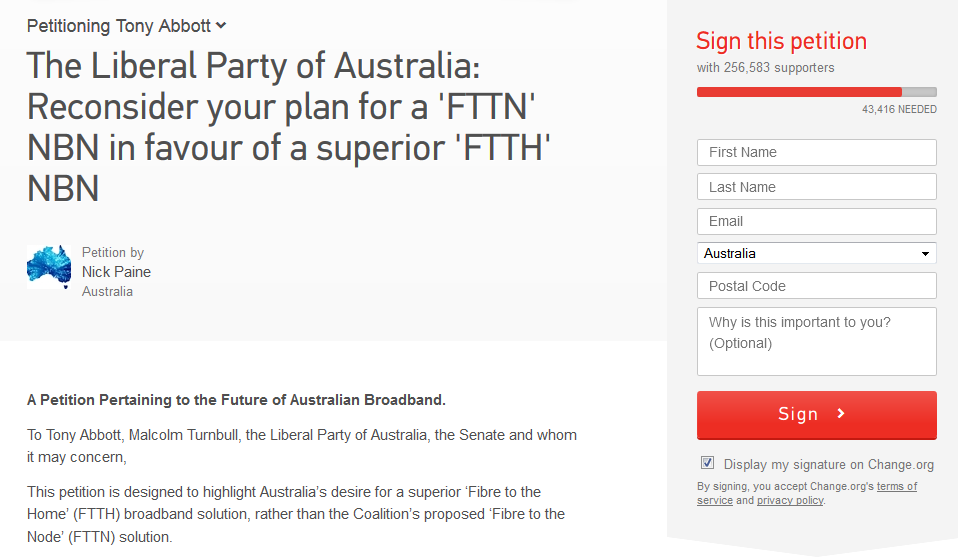- What is the current state of the NBN?
- An NBN refresher: Liberal NBN vs Labor NBN
- Can a petition save FTTH broadband?
Nearly two weeks have passed since the Coalition won the 2013 Federal Election, and Australians are itching to know what will become of Labor’s NBN. Some Australians are even using online social media to protest the Coalition’s version of the NBN in hopes to save Labor’s original vision for Australia. The protest, which comes in the form of an online petition on change.org, urges the new government elect to reconsider its election campaign promise to deliver a modified rollout of the NBN; one that is cheaper and quicker to construct.
Under the Labor government the NBN’s aim was to provide every home access to high speed internet. The majority of connections to the internet would be supplied through a super-fast fibre optic cable straight to the premises, or what is called FTTH (Fibre to the Home). The fibre straight to the premises meant that users could access guaranteed speeds of 100mbps. The plan, however, was not without controversies. The rollout of the network was constantly falling behind schedule, with projected completion dates being pushed back every so often, and the costs of construction were underestimated. Many detractors argued that the NBN was too expensive to build, took too long to roll out and was unnecessary in terms of the extreme high speed.

During their election campaign the Coalition vowed, not to scrap the NBN entirely, but to provide a cheaper and quicker alternative to Labor’s NBN. The Coalition advised this would be done by building the fibre optic cables, not to each house, but to a cabinet on the street. This is what is called FTTN (Fibre to the Node). Each house will then have their existing copper telephone line wired to the cabinet or “node” to access broadband. This would cut costs and have a much quicker timeframe to build. The Coalition promised each house would receive a minimum speed of 20mbps.
Like Labor’s NBN, the Coalition’s NBN also met detractors and opponents particularly because they planned to use the copper network to deliver the NBN service. Part of the current problem with broadband in Australia is that fact that ADSL relies on the copper telephone network. The copper wiring does not conduct the best transmission of data and speeds can vary greatly depending on the location of a person’s house. Many people questioned the Coalition’s ability to guarantee speeds as the copper wiring infrastructure typically cannot achieve a guaranteed speed. Speed is usually determined by location of house and quality and age of the copper telephone line.
The general consensus across telecommunications industry experts is that Labor’s NBN was technically superior to the Coalition’s NBN. This is not say that the Coalition’s NBN is an example of poor policy or that their NBN will be bad quality and will not work; it is simply that Labor’s NBN planned to completely restructure and change the way people access broadband across the country. The Coalition’s NBN does not aim to develop an entire new network, but to simply upgrade what is already there. The Coalition’s plan is still sound and should improve broadband accessibility across the country, but it is not as ambitious or revolutionary as Labor’s NBN.
The supporters of Labor’s NBN have not given up on the hope of having a FTTH national broadband network. Currently, 255,965 supporters of FTTH have signed an online petition at change.org, urging the Coalition to reconsider their plans to only connect to the node. The petition concludes: “Broadband internet is one of many crucial building blocks which creates the underlying foundation for a successful nation… Having a well thought out, well implemented, and well maintained National Broadband Network is about ensuring the prosperity of Australians for generations to come.” Essentially supporters believe that FTTH is worth the extra money and time in the long run.

The petition, however, is unlikely to sway the Coalition’s decision. Communications Minister Malcolm Turnbull has responded to the petition by stating that it would not be democratic to reverse the policy that the Coalition went to the election with. He has argued that the NBN was a key election policy that was heavily debated and considering the Coalition won a majority of seats in the election the Australian people have chosen the Coalition’s NBN. Turnbull is adamant that the majority of Australians prefer their FTTN rather than a FTTH NBN.
It is hard to prove that this is true as Australians would have voted based on many policies, not solely on which version of the NBN they preferred. A more accurate measure of this could be gained by holding a referendum where each voting citizen would have a black and white choice between the two the policies.
Although it is highly unlikely that the Coalition will backflip on their NBN policy it will be interesting to watch the issue unfold during the next couple of months. Will the petition gain more traction and success? Will the Coalition’s NBN be constructed just as they have promised? Considering Labor’s NBN is in mid-rollout and the Coalition is yet to make any deals with Telstra to use their network, Australians may see a revised or different policy altogether. We will just have to wait and see.


